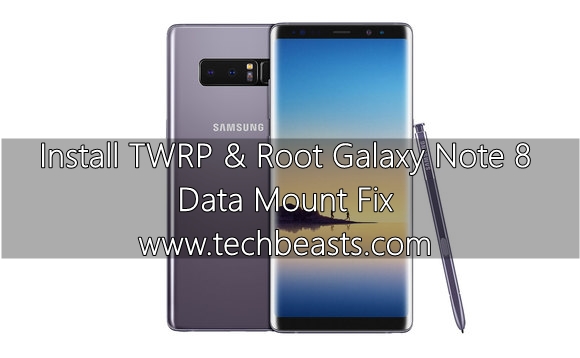Samsung Galaxy Note 8 was updated to Android 8.0 Oreo recently. The update took a very long time to come out. Samsung has never failed to disappoint its users when it comes to software updates. However, it’s better late than never. If you have already updated your Note 8 or you are planning to update it, you will lose the root access and any custom recovery if you have installed one. To get root access and TWRP recovery on Oreo-powered Note 8, you will have to repeat the whole process from scratch.
Installing a new stock firmware restores everything to factory settings. This is why you can lose the root on a previously rooted Galaxy Note 8. To root the phone once again, you can flash the TWRP recovery and then flash the Magisk or SuperSU script to modify your phone. Earlier, there were reports that the existing SuperSU and TWRP were not working with the Android Oreo on Note 8. However, a number of users have successfully rooted their Note 8 with the help of SuperSU as well as Magisk. It turns out that you only have to pick up the right version of TWRP and you have to flash the files carefully.
If you are reading this post at the moment, I’m assuming that you are here to learn how to root and install TWRP on your freshly updated Note 8. Before I take you through the tutorial, it’s important to explain what is root and what is a TWRP custom recovery. If you are a newbie, you can read the explanation and skip it otherwise.
TWRP custom recovery runs in the bootloader of the phone. It replaces the stock recovery of your phone. A custom recovery has loads of options in it. With the help of a custom recovery like the TWRP, you can easily flash .zip and .img files on your phone. The backup option gives the privilege to the users to backup EFS, Nandroid and all other partitions. Using the wipe options, you can wipe the selective partitions of the phone. The most popular use of a custom recovery like the TWRP is to flash a script like SuperSU or Magisk to root the phone. To root the Galaxy Note 8, you need TWRP before you flash the root files.
So, those of you have recently updated their Note 8 to Oreo or those who are planning to update can follow this tutorial now. This tutorial explains how to install TWRP recovery and root Galaxy Note 8 running Android Oreo.
Read Carefully: Rooting your Note 8 via TWRP Recovery will void its warranty and also trip the Knox counter. After you root your phone, you will trigger the dm-verity verification. To bypass this, you must factory reset your phone and it will wipe your phone’s internal storage. It is very important to backup all your data before you root your phone. In the case of any kind of mishap, TechBeasts and the Root developer may not be held responsible. Make sure that you understand the risks involved in the rooting process. You are going to do it at your own risk.
Contents
Root & Install TWRP on Note 8 on Android Oreo
Let’s head over to the guide now. Have a look at the tutorial to root your Android Oreo powered Samsung Note 8 now.
Preparing your Galaxy Note 8 for TWRP recovery
This guide is only for the Galaxy Note 8 Exynos variants.
Charge your phone up to 80% to avoid power issues during the installation process.
Backup your contacts, call logs, SMS messages and important media content.
Enable OEM Unlocking on your phone.
Enable USB debugging mode on your phone as well.
If you are using a Chinese variant of the Galaxy Note 8, then unlock its bootloader.
While using Odin3, disable Samsung Kies if you have it installed on your PC.
Use OEM data cable to connect your phone to your PC.
Downloads required
- Download and install Samsung USB drivers on your PC: Download Link with Guide
- Download and extract Odin 3.13.1 on your PC: Download Link with Guide
- Also, Download the TWRP Recovery.tar file: TWRP for Galaxy Note 8
- Download latest Magisk 16.3.zip or SuperSU.zip file.
- Lastly, Download Galaxy Note 8 Data Mount Fix for Magisk | Data Mount Fix for SuperSU
Install TWRP and Root Galaxy Note 8 running Android Oreo [Exynos]
- Open the Odin3.exe on your computer from the extracted files in Odin.
- In Odin, click on the AP tab and select the recovery.tar file that you just downloaded above.
- The only option checked in Odin should be F.Reset Time. No other option should be ticked.
- Now put your Galaxy Note 8 in download mode. To do so, turn it off first. Now press and hold Volume Down + Bixby + Power button for a while. As soon as the phone turns on with a warning, press the Volume Up button to get into download mode.
- Connect your phone to your PC now.
- Odin will recognize the phone and turn the ID:COM box blue. You will also see the “Added” message in the logs box on the lower left side.
- Now press the “Start” button in Odin. It will begin flashing the recovery on your phone.
- As soon as the recovery flashing ends, disconnect your phone from your PC.
- Press and hold the Volume Down + Bixby + Power key once again. As soon as the screen goes black, quickly switch from Volume Down to Volume Up key while keeping Bixby and Power keys pressed.
- Your phone will boot into TWRP recovery now. It will ask you whether you want to allow modifications. Swipe the screen and get into TWRP now.
- In the main menu in TWRP recovery, tap Wipe > Format Data.
- After formatting the data, get back to the main menu in TWRP recovery.
- Connect your phone to your PC now.
- Copy the SuperSU.zip or Magisk and the Data Mount Fix files to your phone’s internal storage.
- Now disconnect your phone.
- In TWRP’s home-screen, tap Install > Install Zip > flash the SuperSU.zip or the Magisk.zip file similarly.
- Now flash the Data Mount Fix file right after flashing Magisk or SuperSU.
- Go back to the main menu in TWRP > Reboot > System.
- Your phone will take a few minutes to boot up. That’s all.
If you are having any kind of issues, feel free to reach out to me.














binary invalid